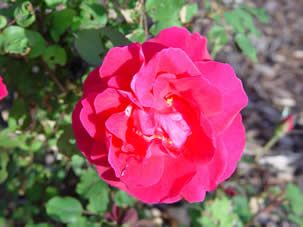Information on Hybrid and Specialty Roses
Hybrid Tea, Floribunda, Miniature, English, Romantica
Here at Gertens, we have quality information on hybrid and specialty roses. Read on to learn what kind of rose is best suited for your garden!
 |
|
Don't forget to protect your roses with the Minnesota Tip Method!
|
Hybrid Tea: The largest class of roses, Hybrid Tea roses are either budded or grafted meaning they are not growing off of their own rootstock. The blooms are usually on a single stem that makes them ideal for cutting. They bloom off and on in spurts throughout the season.
Floribunda: Form clusters of flowers on a single stem. The flowers are usually less fragrant and not as large as the Hybrid Tea rose.
Grandiflora: A cross between a hybrid tea and a floribunda. The flowers are much like the hybrid T, large and more fragrant, but are born in a cluster on a single stem. Blooms can be almost continuous if old spent flowers are removed.
Miniature: Can grow from 8-18”, can bloom in clusters or as single flowers, and are non-fragrant. Many of them are grown on their own rootstock. They will repeat bloom if the spent flowers are removed. Some offsets of the original crown can be cut and planted as a new plant, only if the rootstock is its own.
English: David Austin has hybridized these roses to combine antique rose form and fragrance on modern, ever blooming shrubs. They have a wonderful fragrance and an old world look to the flower.
Romantica: Meidiland, the rose nursery in France, has introduced this line of roses that are very full of petals and look similar to English roses. They all have names of well-known people in history such as Leonardo da Vinci, Toulouse Lautrec, Auguste Renoir etc.
Planting:
Planting varies between types of roses. Most potted plants will be planted the proper way for each type of rose and it is best to plant them as they are in the pot.
Hybrid Tea, Floribunda, Grandiflora: Plant the bud union 1-2” below the soil.
Miniature: Plant bud union or crown 1-2” below the soil.
English and Romanitca: Plant bud union 3-4 inches under the soil.
Care:
Full sun, at least 6 hours of direct sun, in a well-drained, loamy soil. The addition of peat moss to a very clay or a vary sandy site will aid in drainage and nutrient availability to the plant. Adding Root Stimulatorat planting will help with root growth. Plants should have plenty of space to grow so they will get good air circulation around the plant to decrease incidence of disease.
Fertilizing:
Use an organic fertilizer like Rose-Tone by Espoma the first year. This will prevent over fertilizing and the possibility of burning the roots of the plant.
- After the first year, it is best to sprinkle a general rose care fertilizer like Bonide Systemic Rose and Flower Care around the base of each plant in early spring. The amount is variable the smaller the plant, the less you should apply. Water in all fertilizers immediately.
- 2 weeks later: Apply a 20-20-20 like Gertens All Purpose Plant Food.
- 1 week later: Fish Emulsion.
Repeat this cycle for the rest of the season.
Pruning:
Deadheading old blossoms should be done once the flowers begin to fade. You should cut the blooms off at the next leaf with five leaflets. Do any plant shaping and major pruning after the last frost in spring.
Insects and Disease:
Roses are prone to a variety of insects. Begin a spray program every 7 to 10 days using an all purpose insecticide like Eight once insects are noticed. Roses are also prone to funguses. It is important to start a fungicide program such as Infuse when the weather begins to warm up in the spring before any signs of fungus appear. Spray every 7-10 days with a fungicide that is safe for roses. It is also best to vary the types of fungicide as to decrease the incidence of resistant strains of fungus. Please consult with one of our knowledgeable and friendly lawn and garden staff if you have any questions about products or applications.
Uses:
Cut flowers and dried flowers
Winter protection:
Before the rose is protected for the winter spray a fungicide like Infuse on the plant to help decrease the chance of a fungus attacking the plant. All of the roses listed need winter protection. The best way to protect them is by using the MN Tip Method. This is when the plant is placed in a trench that has been dug alongside the plant, the plant tied up, partially dug up and tipped into the trench. Otherwise, the rose can be cut back, soil can be added around the base of the plant with a layer of mulch on top and a rose cone, can also be used to protect the plant.
